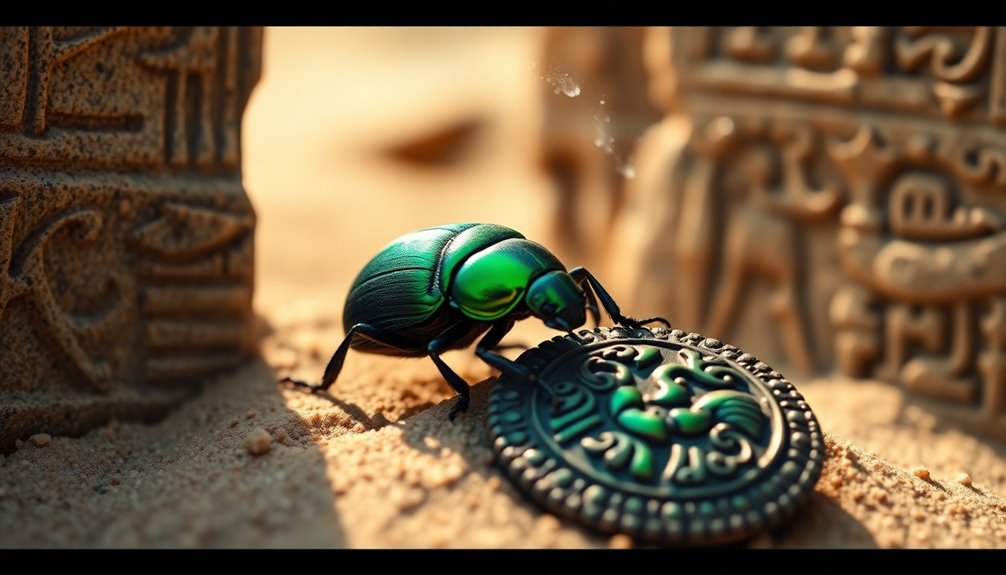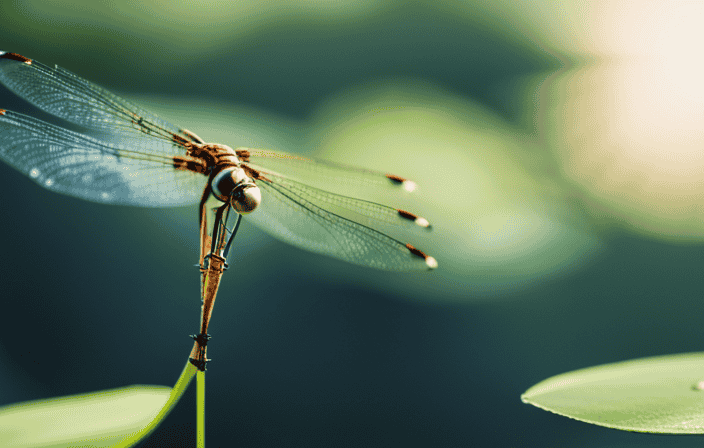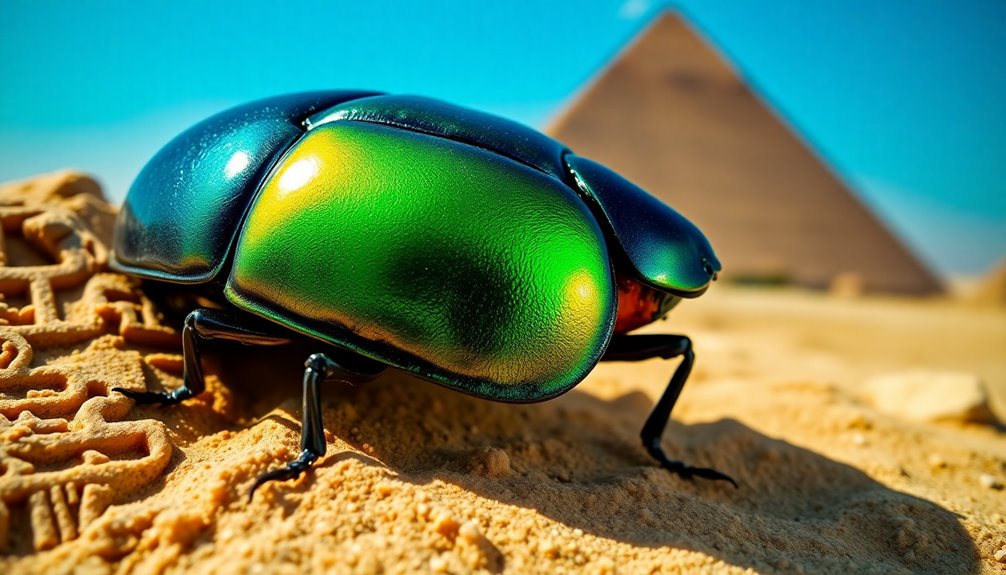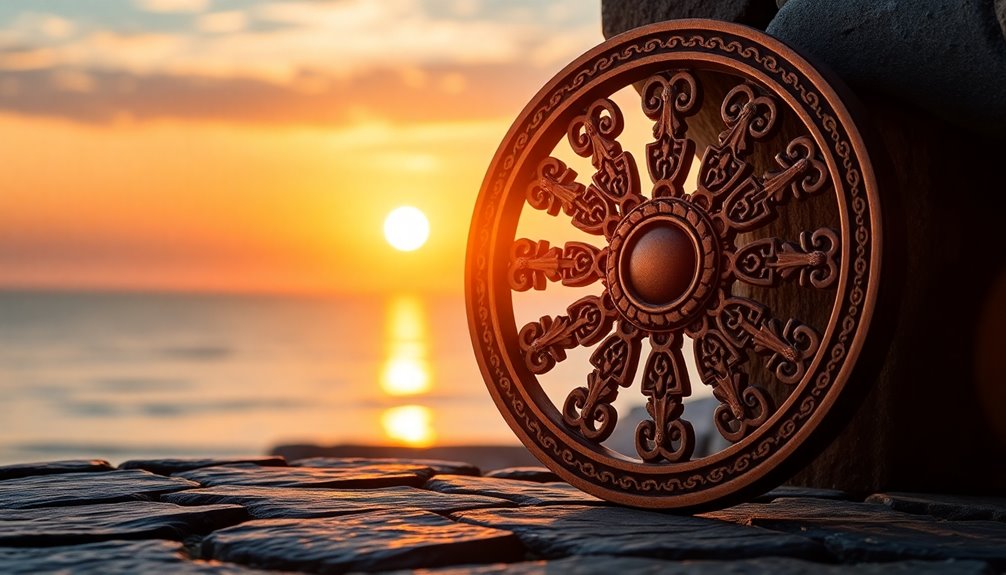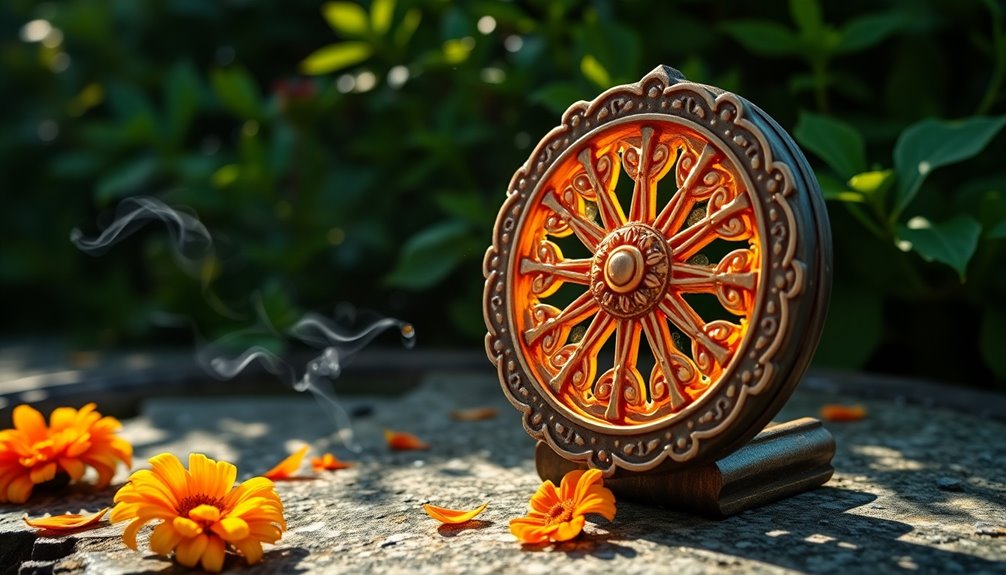The Egyptian scarab beetle's story is both creepy and cool. Revered as sacred insects, scarabs symbolize transformation and renewal, representing the sun god Khepri and the cyclical nature of life. In ancient Egypt, they were more than just bugs; they were amulets placed in tombs to protect the dead and guarantee rebirth in the afterlife. Over time, their designs evolved, becoming exquisite jewelry and artifacts, showcasing skilled craftsmanship. Modern interpretations keep their symbolism alive in art and souvenirs. Curious about how these fascinating insects captured the imagination of ancient Egyptians? There's much more to uncover in their incredible history!
Key Takeaways
- Scarabs, revered in ancient Egypt, symbolize renewal, resurrection, and the eternal cycle of life and death, deeply connected to the sun god Khepri.
- Scarab amulets evolved from simple designs in the Old Kingdom to intricate pieces in the New Kingdom, showcasing advanced artistry and craftsmanship.
- These sacred insects were believed to aid the deceased in achieving rebirth, often placed in tombs as guardians for the soul's journey to the afterlife.
- Scarabs continue to represent protection and good fortune, inspiring modern interpretations through jewelry, art, and tattoos, emphasizing transformation themes.
- Collecting ancient scarabs requires careful evaluation of authenticity, focusing on inscriptions, materials, and provenance to ensure historical significance and value.
Egyptian Scarabs and Dung Beetles

In ancient Egypt, the fascinating relationship between scarab beetles and dung beetles reveals much about the culture's beliefs and values. You'd find that the scarab beetle, modeled after the dung beetle, was revered for its remarkable behavior of rolling dung balls. This act symbolized the cyclical nature of life and the universe's perpetual motion, vital concepts in Egyptian thought.
The scarab beetle was closely linked to Khepri, the god who represented the rising sun. This connection underscored the principles of renewal and rebirth, making scarabs significant in daily life and spiritual practices.
As you explore ancient Egyptian culture, you'll discover that scarabs were crafted into amulets, symbolizing protection and good fortune. These amulets played an important role in funerary practices, ensuring safe passage to the afterlife.
The first scarab amulets appeared during the Old Kingdom and evolved into intricately designed objects with deep religious significance. Funerary scarabs often showcased wings, which represented a peaceful passage to the afterlife, and were typically attached to mummy wrappings.
Understanding these connections helps you appreciate the importance of scarab beetles in ancient Egyptian society.
Symbolism of Resurrection

Scarabs hold profound significance in ancient Egyptian culture, particularly as symbols of resurrection. These remarkable insects epitomized the eternal cycle of life and death, embodying the belief in rebirth and the afterlife. Each day, as the sun rose, it mirrored the regenerative powers of the scarab, reinforcing its connection to resurrection.
In ancient Egypt, scarabs weren't just fascinating creatures; they were seen as protectors for the deceased, believed to aid them in achieving rebirth in the afterlife. You'd find scarab amulets placed in tombs, serving both as guardians and guides for the souls commencing on their journey beyond.
Moreover, the scarab's association with the god Khepri, who represented renewal, further emphasized their role in resurrection beliefs. This deity was often depicted as a scarab, symbolizing the hope for immortality that the ancient Egyptians cherished.
Scarab imagery adorned funerary art, reflecting the deep cultural importance of life emerging from death. Through these symbols, the ancient Egyptians expressed their enduring hope for life after death, making scarabs a powerful representation of resurrection in their spiritual beliefs.
Connections to Ancient Gods

The profound connection between scarabs and ancient Egyptian gods reveals a rich tapestry of mythology and symbolism. You'll find that scarab beetles were closely linked to Khepri, the god of the rising sun. This association symbolizes renewal and the eternal cycle of life and death, which is central to ancient Egyptian beliefs.
Scarabs also represented Atum, the embodiment of primordial creation, and Re, the sun god, collectively illustrating the sun's creative power.
In religious art, scarabs often sported wings, symbolizing Khepri's flight and the concept of rebirth. When you look at these depictions, you can see how the ancient Egyptians perceived scarabs as a physical manifestation of divine authority. They believed these insects provided protection for the deceased in the afterlife, reinforcing their role as symbols of resurrection.
The reverence for scarab beetles wasn't just an aesthetic choice; it reflected a deep belief in life emerging from death. The daily rebirth of the sun under Khepri's watchful eye further solidified this connection, ensuring that scarabs remained integral to ancient Egyptian spirituality and culture.
Evolution Through the Dynasties
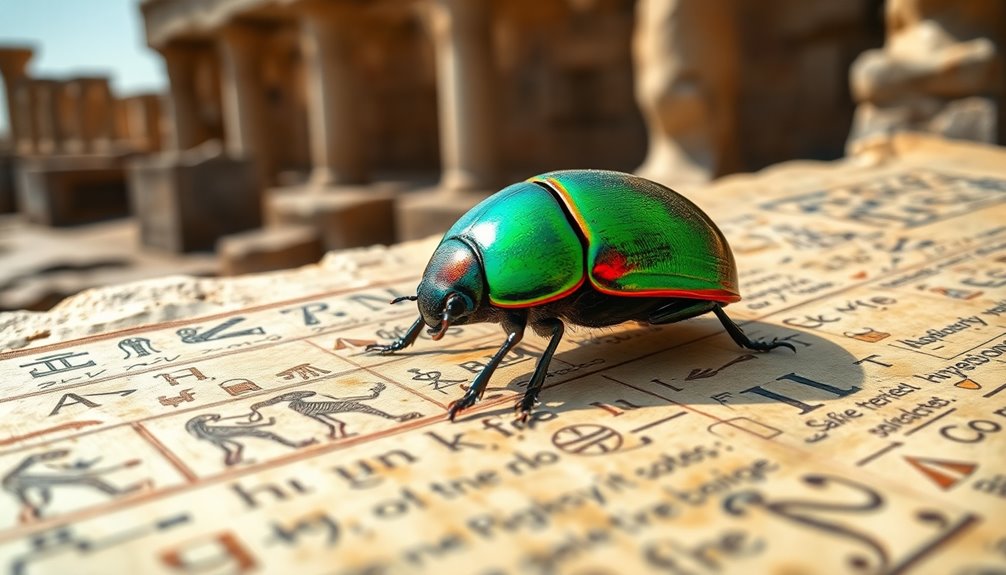
As ancient Egyptian society evolved through its dynasties, so did the significance and craftsmanship of scarab amulets. The first scarab amulets appeared during the Old Kingdom, particularly in the 6th Dynasty, as uninscribed stone seals, marking their cultural emergence.
By the Middle Kingdom, these amulets converted into seals and daily objects, showcasing a growing popularity among the populace.
In the New Kingdom, scarabs gained profound religious importance, often inscribed and placed in tombs as heart scarabs to aid the deceased in their afterlife journey. This shift reflected the changing beliefs and practices of Ancient Egyptian society.
Throughout the dynasties, scarab artistry flourished, evolving from simple designs to intricate pieces crafted from materials like faience and gemstones.
Significantly, scarabs commemorating pharaohs' achievements emerged, especially during the reign of Amenhotep III, celebrating significant events and milestones.
This evolution highlights how scarab amulets not only retained their cultural significance but also adapted to the spiritual and artistic needs of their time, making them enduring symbols of Ancient Egyptian heritage.
Scarabs in Jewelry and Art

In ancient Egypt, scarabs transformed from functional seals into exquisite pieces of jewelry, showcasing the remarkable skills of artisans. By the New Kingdom, these beetles became highly sought-after items, crafted from materials like faience, steatite, and gemstones.
You'd often find scarab jewelry worn as amulets, believed to provide protection and good fortune. Additionally, the symbolism of scarabs, particularly their association with rebirth and regeneration, reflects the ancient Egyptians' deep connection to the natural world and its cycles.
Winged scarabs held a special place in Egyptian religion, symbolizing rebirth and the soul's journey to the afterlife. Artisans incorporated them into various items, including necklaces, tiaras, bracelets, and earrings, merging aesthetic beauty with spiritual significance.
These intricate designs reflected the culture's deep reverence for the scarab beetle, which was seen as a powerful symbol of regeneration.
Today, the popularity of scarabs in jewelry continues, with modern interpretations celebrating their ancient motifs. Many people still wear these pieces, connecting to the rich history and timeless symbolism of rebirth and renewal.
The legacy of scarabs in art remains a proof of ancient Egyptian craftsmanship and belief, ensuring that these sacred insects continue to inspire and fascinate.
Funerary Practices and Beliefs

Funerary practices in ancient Egypt reveal a deep-seated belief in the afterlife, with scarab beetles playing an essential role in ensuring safe passage for the deceased. The ancient Egyptians viewed the scarab as a powerful symbol of protection and resurrection, deeply intertwined with their beliefs about the cycle of life.
Here are three key aspects of scarab beetles in funerary customs:
- Heart Scarabs: These amulets, often inscribed with spells, were placed on the heart of the deceased during mummification. They aided in judgment in the afterlife, ensuring the heart weighed favorably against the feather of Ma'at.
- Tomb Inclusions: Scarab beetle amulets were commonly included in tombs. They symbolized the protective qualities believed to help the deceased navigate the dangers of the afterlife.
- Artistic Depictions: Funerary art frequently showcased winged scarabs, representing the soul's transformation and its journey to the afterlife, emphasizing the belief in rebirth and the cycle of life.
Incorporating scarabs into burial practices not only honored the dead but also reinforced the idea of a protective journey toward eternal life.
Modern Cultural Significance
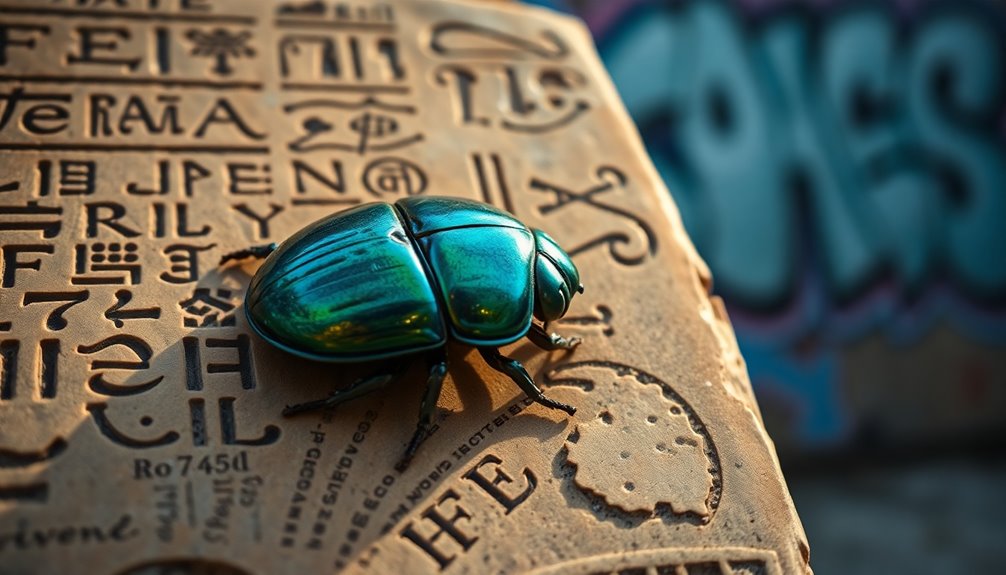
Today, scarabs frequently symbolize protection and good fortune, transcending their ancient origins to find a place in modern culture. You'll find these beetles represented in various forms, from jewelry and art to tattoos. Each piece often embodies themes of rebirth and transformation, echoing the beliefs of ancient Egyptians.
Many tourists flock to Egyptian markets, enthusiastic to purchase scarab replicas and amulets. These items not only signify their continued cultural relevance but also serve as cherished souvenirs. Scarab tattoos have surged in popularity, reflecting a desire for renewal and immortalizing ancient motifs in contemporary fashion.
Here's a quick overview of modern scarab significance:
| Symbol | Meaning |
|---|---|
| Protection | Safeguarding against harm |
| Good Fortune | Attracting positive energy |
| Rebirth | Embracing new beginnings |
| Transformation | Facilitating personal growth |
Despite losing some original religious significance, scarabs continue to captivate people worldwide for their historical and artistic value. In this way, these sacred insects remain crucial symbols of protection and good fortune in our lives today. Moreover, the symbolism of scarabs resonates with the concept of personal growth, illustrating how ancient beliefs can inspire modern transformations.
Collecting Ancient Scarabs

When you start collecting ancient scarabs, knowing how to evaluate their authenticity is essential.
You'll want to familiarize yourself with the signs of genuine artifacts versus common forgeries.
With the right tips, you can confidently navigate the market and build a valuable collection.
Scarab Collecting Tips
As you immerse yourself in the fascinating world of collecting ancient scarabs, it's crucial to prioritize authenticity by purchasing from certified dealers. The market is full of imitations, and ensuring you acquire genuine pieces will save you time and money in the long run.
Here are three tips to enhance your scarab-collecting journey:
- Focus on Historical Significance: Scarabs from the Old Kingdom (6th Dynasty) are rarer and often more valuable than those from later periods. Their historical context adds depth to your collection.
- Examine Inscriptions: Pay attention to unique engravings on the scarabs. These inscriptions can provide insights into their origins and purposes, and they can greatly enhance the scarabs' value.
- Material Matters: Scarabs made from premium materials like gold or semiprecious stones, such as lapis lazuli or carnelian, are highly sought after. They usually command higher prices, so consider these when expanding your collection.
Join collector forums or attend auctions to connect with fellow enthusiasts and stay updated on market trends.
Happy collecting!
Evaluating Scarab Authenticity
Authenticity is paramount in the domain of collecting ancient scarabs, and knowing how to evaluate it can save you from costly mistakes. Many forgeries flood the market, so verifying provenance is crucial. Look for key characteristics that can help you distinguish genuine artifacts from fakes.
| Key Factor | What to Look For |
|---|---|
| Inscriptions | Old Kingdom scarabs often lack them; New Kingdom pieces feature detailed carvings or hieroglyphs. |
| Material | Genuine scarabs are typically made from faience, steatite, or gemstones with distinct wear patterns. |
| Provenance | Ask for documentation that traces the scarab's history and legal acquisition. |
| Dealer Credibility | Purchase from major auction houses or certified dealers for assurance. |
| Price Variability | Understand that size, rarity, and craftsmanship influence price, so do your research! |
Just like dung beetles lay their eggs in dung for survival, you want to guarantee your collection is rooted in authenticity for lasting value. By following these guidelines, you'll enhance your collecting experience and avoid pitfalls. Happy collecting!
Frequently Asked Questions
What Is the Sacred Insect in Egypt?
The sacred insect in Egypt is the scarab beetle, known for its powerful symbolism.
You'll find that the ancient Egyptians revered it for its connection to life, death, and rebirth. Scarabs were believed to represent resurrection, and they rolled dung balls that mirrored the sun's journey.
Often, you'd see scarab amulets placed in tombs to help guide the deceased into the afterlife, showcasing their importance in Egyptian culture and religion.
What Does the Egyptian Bug Symbolize?
You might think of the scarab beetle as just an insect, but it symbolizes so much more in ancient Egyptian culture. It represents the eternal cycle of life, death, and rebirth.
This tiny creature's behavior of rolling dung mirrors the sun's journey, linking it to creation. Scarabs were believed to offer protection, often used as amulets in funerary practices, ensuring safe passage to the afterlife.
They're not just bugs; they embody divine power and immortality.
What Is the Bug Egyptian God?
The bug Egyptian god you're looking for is Khepri, often depicted with a scarab beetle for a head. Khepri represents the rising sun and the concept of renewal.
You'll notice that the scarab's behavior of rolling dung was symbolic of the sun's journey across the sky, highlighting transformation and the cycle of life.
In ancient Egypt, scarabs were more than just bugs; they were powerful symbols of protection and rebirth.
What Is the Secret Beetle in Egypt?
The secret beetle in Egypt is the scarab beetle, known for its unique behavior of rolling dung.
You might find it fascinating that ancient Egyptians viewed this beetle as a symbol of transformation and renewal. They associated it with the sun god Khepri, who represented rebirth.
Scarabs weren't just insects; they were powerful symbols, often used in amulets to protect the deceased and guarantee their safe passage into the afterlife.
Conclusion
In the shadow of the Great Pyramids, the scarab's story continues to resonate. These sacred insects, once revered as symbols of rebirth, whisper echoes of ancient rituals and divine connections. As you explore their legacy, imagine the vibrant jewelry adorning pharaohs and the intricate art that captured their essence. Today, the allure of collecting these tiny treasures invites you to join a timeless journey, linking you to the mysteries and marvels of a civilization that thrived in the sands of time.
